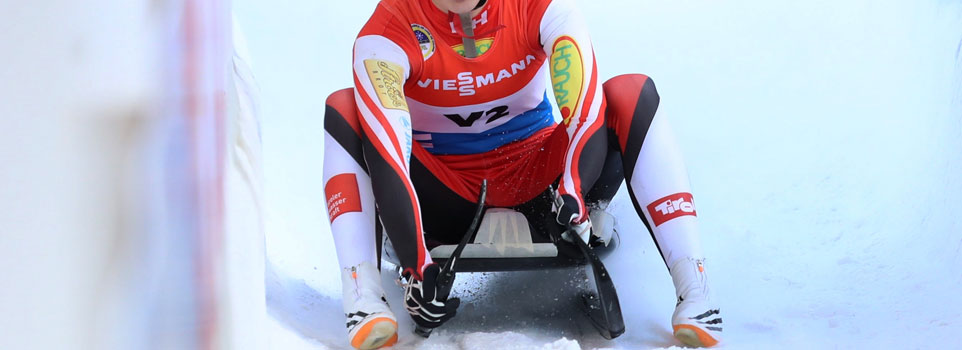Luge is one of the fastest and dangerous sports in the world with players riding sleds down an artificial track built with steep banks and inclines. Despite the fact this sport can easily break your back in less than a minute, if you steer in the wrong direction, it is part of the Olympics.
During their sled, Lugers can reach the speed of 140 km/h which makes it very difficult for them to maintain control.

This winter sport originated in St Moritz, Switzerland. This place has a rich history regarding the development of different winter sports like Skeleton and Bobsleigh, which are quite similar to Luge.
Also, there is an evidence that Luge races have been held before, back in 800 AD with Vikings using sleds to compete against each other on the Oslofjord mountains. The very first recorded international Luge event was held in 1833, in which 7 different national teams competed against each other.
Object of Playing Luge
The object of the game is to reach the end of the track in minimum time possible. This is done by using a sled on which players lay down and steer the sled by using their calf muscle or by exerting opposite shoulder pressure to the seat.
The faster you go, the more chances you have of winning. But going faster in not the only challenge but maintaining control while steering is perhaps the most tricky and dangerous part of the race.
How to Play?
Luge is a team sport in which an individual or a team of 2 players lay down on the sled and the sled goes down the artificial snow slope. Teams go down the slope in turns and the fastest to finish the lap wins the game.
There are strict rules regarding what kind of Sled you can use in Luge and what should be its weight, infringements of the rules can result in disqualification from the race. To have your every query answer regarding the game, make sure you read the article till the end.
General Rules of Luge
- General rules are the same for individual and double races.
- In single tournaments, usually, a player is supposed to complete 4 runs down the track.
- In double tournaments, this comes downs to 2 runs down the track.
- Luge sleds are weighted before every race in order to determine that Luge sled is according to the specifications of the tournaments. Heavier sleds can offer unfair advantage by going down faster.
- Teams or players found doing any alteration to their sled in order to gain unfair advantage can be disqualified from the race, or tournament, in worst cases.
Time Duration of a Game
There is no time limit. Players are supposed to complete a series of runs, and regardless of length of the track, 2-3 minutes prove sufficient for one player to complete his turn.
Playing Field
The track used for Luge is not an ordinary track but takes year-round maintenance in order to keep it in good shape. The surface is always horizontal and naturally iced. The slope area for the entire track should not be more than 15%.
The overall dimension of a track can vary as there is no specific limit, and the time taken by the Luger to complete one lap or complete run depends upon the length of the track.
Playing Equipment
A sled is supposed to be the most important equipment for the game, without it players can’t even participate. But considering the lingering threat of a career-ending injury during the race propels players to always wear protective equipment during the competition.
Sled: The weight and size of the sled can vary from tournament to tournament. Players are only allowed to use certain sized and weighted sleds for a particular tournament. Moreover, a sled should be sturdy enough to bear the weight of a player while going zig zag and during sharp turns because little fragility can inflict irreparable damage to the player.
Protective equipment: All competitors are required to wear helmets, racing boots and spiked gloves. Players wear a skin-tight rubber suit to improve aerodynamics while racing.
Famous Luge Events
Luge has been part of the Olympics and can also be seen in several Luge events held in European and a few other countries with cold weather, which makes them an ideal place for setting up Luge tracks. Some of the famous Luge events are:
- World Championship
- Olympics
- European Championship
National level events are also held in countries like the USA, Germany and Canada where local players show their Luging skills and contribute to the nourishment of the game.
Famous Luge Venues
As said earlier, Luge tracks are not ordinary tracks and they can be made and maintained in cold weather conditions. Here are some of the famous Luge venues in the world.
- Sochi, Russia
- St Mortiz, Switzerland
- Lake Placid, USA
- Park City, USA
Governing Body
The International Luge Federation (French: Fédération Internationale de Luge de Course (FIL); German: Internationaler Rennrodelverband) is the international governing body for the game.
The federation was founded by 13 nationals at Davos, Switzerland in 1957. Until 2009, it consisted of 53 national Luge associations and its current headquarters is based in Berchtesgaden, Germany.
Difference Between Luge and Bobsleigh
Though both the games appear quite similar to each other, there are a few primary differences between the both.
- Bobsleigh can’t be experienced alone. A pair of two is mandatory for a race. On the other hand, Luge is more popular as an individual sport.
- In Bobsleigh, players sit in their sleds. While in the Luge, players lay down on their back and sled down.
- There are no brakes available on the sled in Luge, players have to use their boots to stop the sled.
